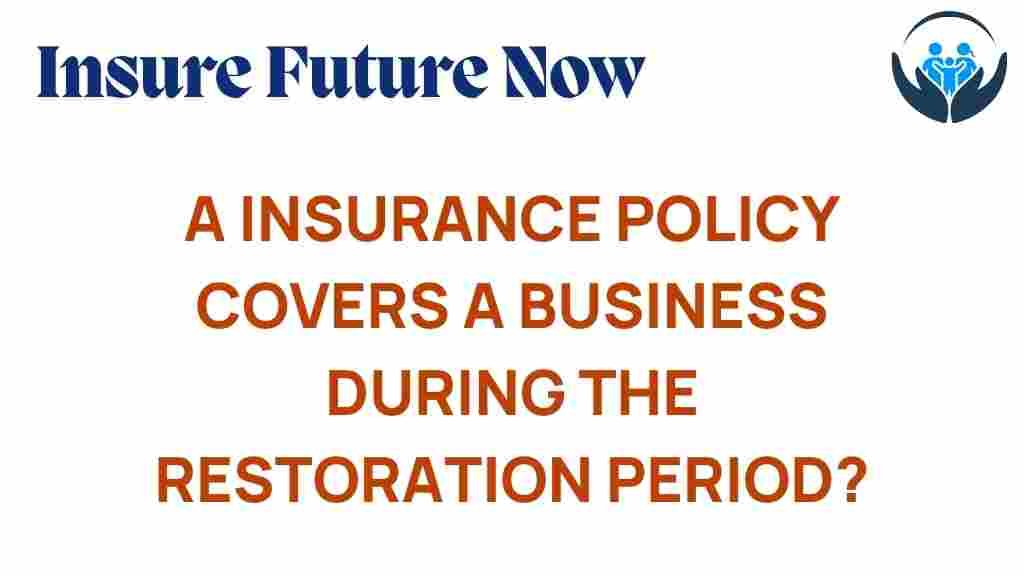How Insurance Policies Safeguard Businesses During Restoration Periods
In today’s dynamic business environment, companies face various risks that can disrupt their operations. Whether it’s a natural disaster, a fire, or another unforeseen event, the aftermath can be devastating. This is where an effective insurance policy comes into play. It acts as a protective shield, offering financial protection and support during critical business restoration periods. In this article, we will explore how insurance coverage can aid businesses in navigating the complexities of disaster recovery.
The Importance of Insurance Policies for Businesses
Insurance policies are essential for businesses of all sizes, particularly for small businesses that may lack the financial resilience to recover from significant losses. Here are some key benefits:
- Financial Protection: Insurance can cover repair costs, lost revenue, and other expenses incurred during the restoration period.
- Risk Management: By assessing potential risks and obtaining adequate coverage, businesses can minimize their exposure to financial losses.
- Claims Process Support: Insurance companies often provide guidance on navigating the claims process, ensuring businesses receive the support they need.
Types of Coverage for Business Restoration
Understanding the various types of coverage available is crucial for effective risk management. Here are some common types of insurance policies that can aid in disaster recovery:
- Property Insurance: Covers damages to physical assets, such as buildings and equipment.
- Business Interruption Insurance: Compensates for lost income during the restoration period.
- Liability Insurance: Protects against legal claims arising from accidents or injuries on business premises.
- Workers’ Compensation Insurance: Covers medical expenses and lost wages for employees injured on the job.
Step-by-Step Process: How to Ensure Adequate Coverage
To effectively safeguard your business during restoration periods, follow this step-by-step process to ensure you have the right insurance coverage:
Step 1: Assess Your Risks
Begin by identifying the potential risks your business faces. Consider factors such as:
- Location (e.g., areas prone to flooding or earthquakes)
- Type of business (e.g., manufacturing, retail)
- Value of assets
Step 2: Review Your Current Policies
Examine your existing insurance policy to determine what coverage you currently have. Look for gaps in coverage that may leave your business vulnerable during restoration periods.
Step 3: Consult with an Insurance Agent
Engage with an insurance agent who specializes in business restoration. They can help you understand the nuances of different policies and recommend the best options based on your specific needs.
Step 4: Customize Your Coverage
Based on your risk assessment and advice from your insurance agent, customize your policies to ensure comprehensive coverage. Consider increasing limits or adding endorsements for better protection.
Step 5: Understand the Claims Process
Familiarize yourself with the claims process of your insurance provider. Knowing how to file a claim and the necessary documentation can expedite the process when you need it most.
Step 6: Regularly Update Your Policies
As your business evolves, so do your risks. Regularly review and update your insurance policies to reflect changes in your business operations, assets, or risk profile. This ongoing process is essential for effective risk management.
Troubleshooting Tips for Common Issues
Even with a solid insurance policy in place, businesses may encounter challenges during the restoration process. Here are some troubleshooting tips:
1. Delayed Claims Processing
If you experience delays in the claims process, consider taking the following steps:
- Contact your insurance adjuster for updates on your claim status.
- Ensure all required documentation is submitted accurately and completely.
- Keep records of all communications with your insurance provider.
2. Insufficient Coverage
If you find that your coverage is inadequate, take immediate action:
- Review your policy limits and compare them with your current asset values.
- Consult with your insurance agent to discuss options for increasing coverage.
- Consider additional endorsements for specific risks that may not be fully covered.
3. Disputes Over Claims
In the event of a dispute, follow these steps:
- Request a detailed explanation from your insurer regarding the claim denial.
- Gather supporting documentation to contest the decision.
- Consider involving a public adjuster or legal counsel for assistance.
Conclusion
In conclusion, having a robust insurance policy is vital for businesses, especially during business restoration periods following a disaster. The right coverage not only provides financial protection but also aids in effective risk management and a smooth claims process. By understanding the various types of coverage available and following a systematic approach to ensuring adequate coverage, businesses can safeguard their operations against unforeseen events. Don’t underestimate the importance of regularly reviewing and updating your policies to align with your evolving business needs.
For more information on selecting the right insurance policy for your business, visit this resource. If you’re looking for expert advice on insurance for small businesses, check out this guide.
This article is in the category Coverage and created by InsureFutureNow Team
